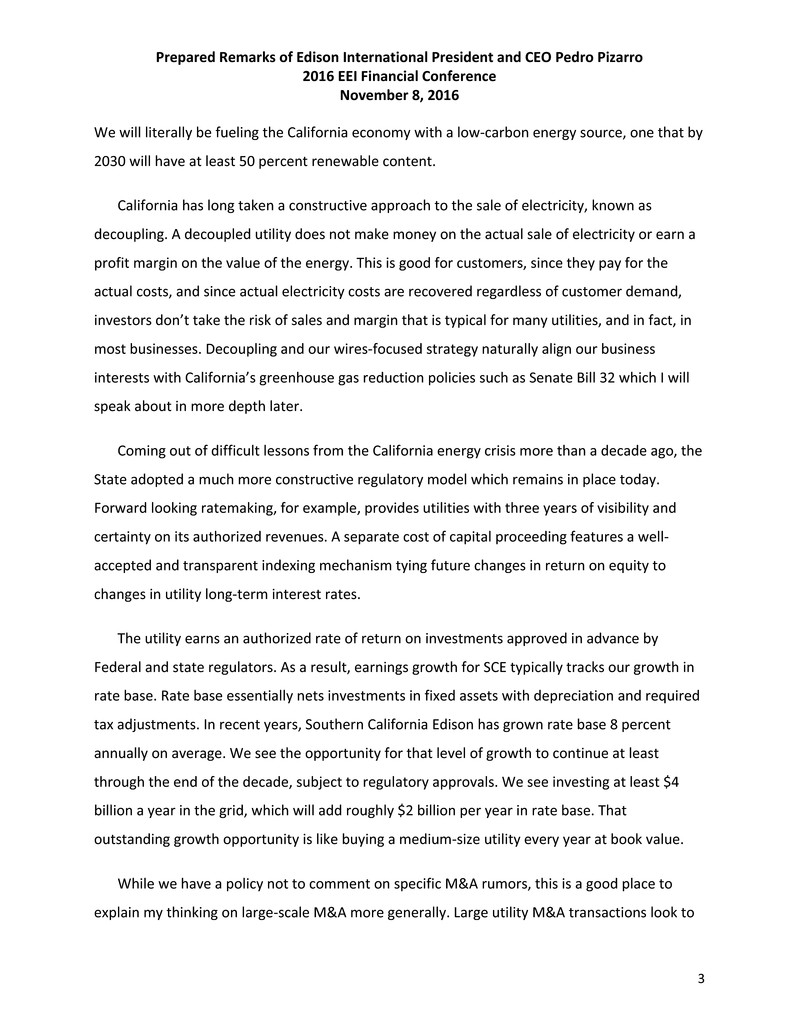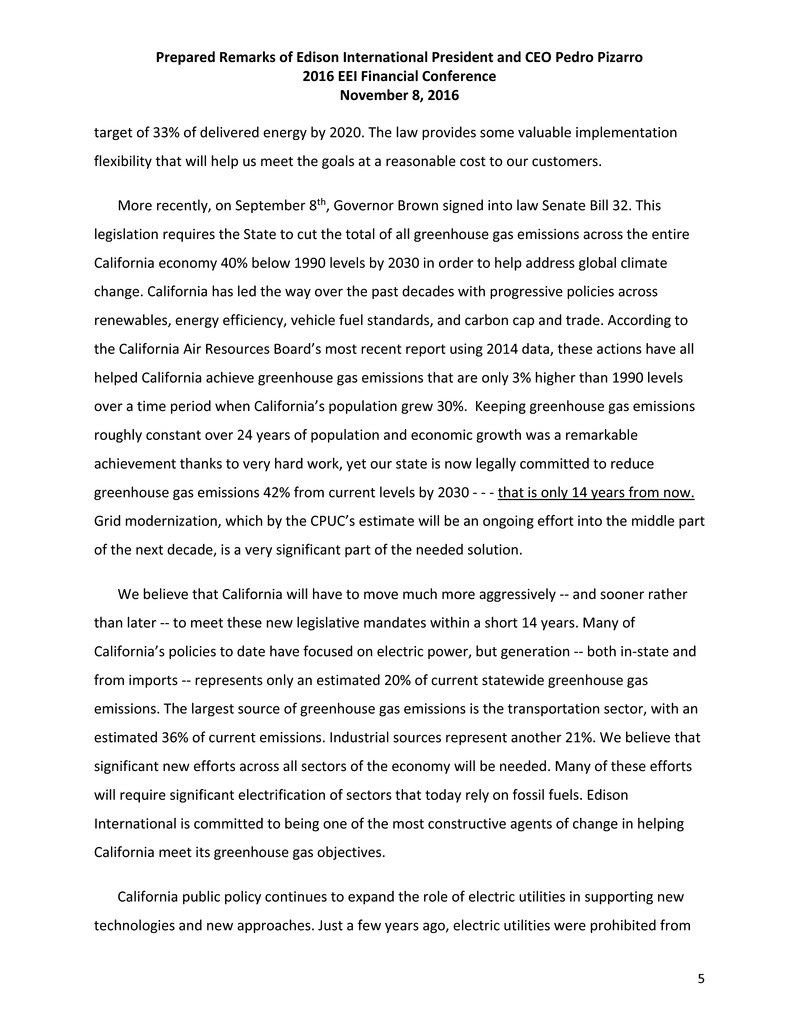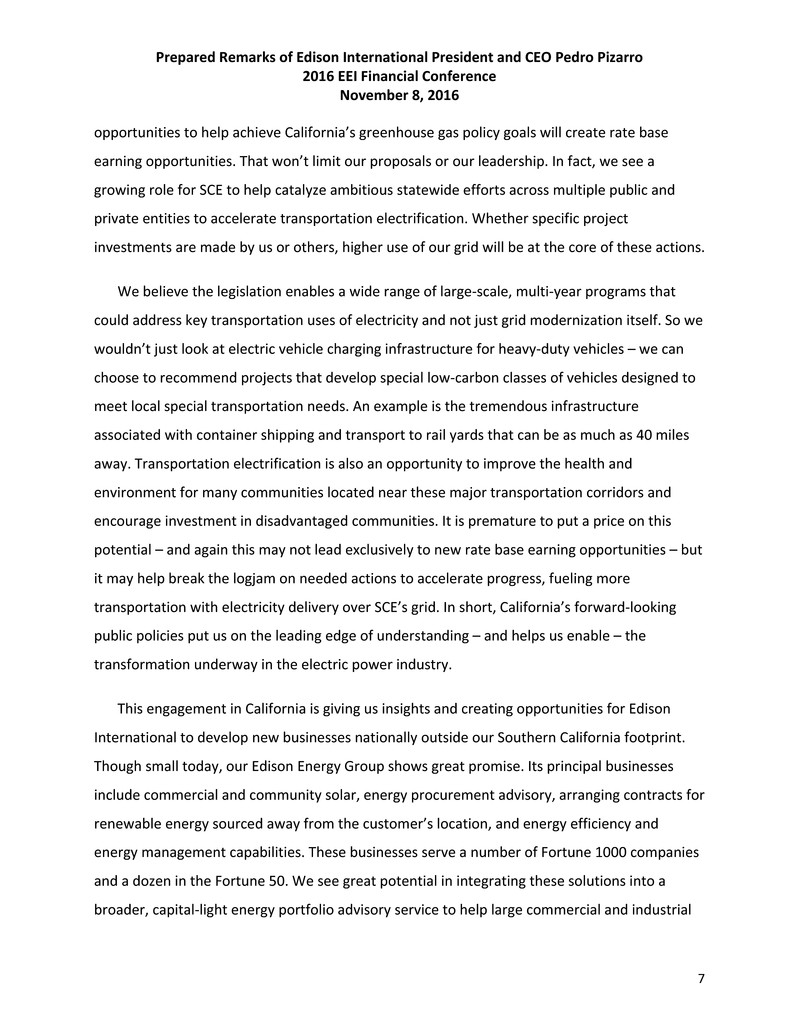
Prepared Remarks of Edison International President and CEO Pedro Pizarro 2016 EEI Financial Conference November 8, 2016 1 Good morning to those of you here in Phoenix and to those of you attending via webcast. I’m Pedro Pizarro, President and Chief Executive Officer of Edison International. Thanks for your interest in learning more about our company. I became President and Chief Executive Officer last month upon Ted Craver’s retirement on September 30th. Our leadership team, some of whom are with me here today, and our Board of Directors have done a tremendous job positioning Edison International to deliver our significant value creation opportunity for investors. Continuity of leadership and continuity of strategy have been my key messages while meeting with sell‐side analysts and many of our investors in September. Today I look to paint a clear picture of our business and financial strategies. Edison International is uniquely positioned to lead the transformative change underway in the electric power industry. Nationally, we’re seeing public policy and new technologies as the key drivers. California’s environmental policy objectives are accelerating the pace and scope. We see the electric grid as a key enabler of California’s climate change and greenhouse gas reduction goals. The grid is also key to enabling more customer choices in how they use new energy technologies. Our principal business today is Southern California Edison. We have a much smaller competitive business platform, Edison Energy Group, which I’ll touch on later in my remarks. SCE is purely an electric utility, one of the largest in the U.S. Given its size and location, it is front‐and‐center in grid modernization. SCE serves almost 15 million people in a 50,000 square mile service territory. This includes most of the greater Los Angeles region other than the City of Los Angeles and a few suburbs with municipal utilities. SCE moves energy across 100,000 miles of distribution and transmission lines. Importantly, it generates less than 20% of the power delivered to customers. These last two points demonstrate one element of how we’ve repositioned SCE. SCE is focused on the wires side of the business rather than on generation. Wires assets represent

Prepared Remarks of Edison International President and CEO Pedro Pizarro 2016 EEI Financial Conference November 8, 2016 2 over 90% of our physical assets. Our approach to generation is aligned with California’s policy preference for competitive power markets. We buy more than 80 percent of the energy we deliver from third parties. Our own generation portfolio does offer a low‐carbon footprint as well, led by our Big Creek hydroelectric system in the Sierra Nevada Mountains, along with a modest amount of newer high‐efficiency gas‐fired generation. We see the wires business as lower risk for investors. Conventional natural gas‐fired generation faces tough long‐term market conditions in California, as gas‐fired generation is slowly being displaced by renewable sources of energy. Natural gas combustion is also increasingly being targeted by environmental advocacy groups lobbying for stringent limits on greenhouse gas emissions. Over time, renewable resources will also see further technology advancements, potentially putting even utility‐owned renewable investments at risk of becoming a less‐competitive solution for customers. Upfront prudency standards increase certainty of our cost recovery for purchased power. We expect overall electricity use to grow modestly over time, especially as transportation electrification becomes more widely adopted. Until that happens, we see electricity demand delivered by utilities trending flat to down over time due to the expected increase in distributed generation and energy efficiency. This view on the future of the electric grid and of large‐scale generation is fundamental to our strategy. It informs our decisions and is the foundation to the commitment we have to our customers and owners. The electric grid of the future may look somewhat like it does today. It will still have large‐ scale transmission systems moving power regionally and local distribution systems delivering energy to neighborhoods and individual customers. Underneath, though, will be a technology‐ rich environment ready to enable large‐scale adoption of new technologies to generate, store, and efficiently use electricity. Referred to as distributed energy resources, these include rooftop solar, electric vehicle charging, energy storage, energy conservation measures and many more.

Prepared Remarks of Edison International President and CEO Pedro Pizarro 2016 EEI Financial Conference November 8, 2016 3 We will literally be fueling the California economy with a low‐carbon energy source, one that by 2030 will have at least 50 percent renewable content. California has long taken a constructive approach to the sale of electricity, known as decoupling. A decoupled utility does not make money on the actual sale of electricity or earn a profit margin on the value of the energy. This is good for customers, since they pay for the actual costs, and since actual electricity costs are recovered regardless of customer demand, investors don’t take the risk of sales and margin that is typical for many utilities, and in fact, in most businesses. Decoupling and our wires‐focused strategy naturally align our business interests with California’s greenhouse gas reduction policies such as Senate Bill 32 which I will speak about in more depth later. Coming out of difficult lessons from the California energy crisis more than a decade ago, the State adopted a much more constructive regulatory model which remains in place today. Forward looking ratemaking, for example, provides utilities with three years of visibility and certainty on its authorized revenues. A separate cost of capital proceeding features a well‐ accepted and transparent indexing mechanism tying future changes in return on equity to changes in utility long‐term interest rates. The utility earns an authorized rate of return on investments approved in advance by Federal and state regulators. As a result, earnings growth for SCE typically tracks our growth in rate base. Rate base essentially nets investments in fixed assets with depreciation and required tax adjustments. In recent years, Southern California Edison has grown rate base 8 percent annually on average. We see the opportunity for that level of growth to continue at least through the end of the decade, subject to regulatory approvals. We see investing at least $4 billion a year in the grid, which will add roughly $2 billion per year in rate base. That outstanding growth opportunity is like buying a medium‐size utility every year at book value. While we have a policy not to comment on specific M&A rumors, this is a good place to explain my thinking on large‐scale M&A more generally. Large utility M&A transactions look to

Prepared Remarks of Edison International President and CEO Pedro Pizarro 2016 EEI Financial Conference November 8, 2016 4 be very expensive, as some utilities feel pressure to acquire to fill in gaps in their organic growth. That isn’t the case with SCE and it is the reason, in fact, why I feel zero pressure to buy assets through M&A. We never say never, but any acquisition would have to clear a very high bar to make sense for our investors. Looking ahead, Southern California Edison’s business strategy has three key elements. The first is investing to maintain a safe and reliable wires network. Much of our system dates back to the booming economy post World War II and we still have lots of infrastructure from that period facing the end of its useful life. Although we have made progress, it takes time to ramp up spending and SCE is still not investing at levels required to sustain a target average age of these assets that matches their expected lifetimes. The second element is modernizing the grid to enable increased penetration of distributed energy resources. These resources support California's greenhouse gas reduction objectives and empower our customers to make new energy technology choices. And finally, SCE will continue its operational excellence journey to achieve top performance across safety, reliability, customer satisfaction, and cost. I am excited about the opportunity at Southern California Edison to truly redefine what it means to be a great utility and thrive in the new world of energy. The 2018 General Rate Case filed with the California Public Utilities Commission on September 1st demonstrates SCE’s commitment to each of these strategy elements. We have made a strong case for our strategy and for the requested rate case funding levels. Traditional regulatory filings such as the General Rate Case are not the only way we can help California meet its policy objectives. In fact, the Legislature and the Governor have taken important steps to expand the role electric utilities play. Just over a year ago, Governor Brown signed into law the mandate I mentioned earlier to deliver 50% of electricity from qualifying renewable sources by 2030, building on the earlier

Prepared Remarks of Edison International President and CEO Pedro Pizarro 2016 EEI Financial Conference November 8, 2016 5 target of 33% of delivered energy by 2020. The law provides some valuable implementation flexibility that will help us meet the goals at a reasonable cost to our customers. More recently, on September 8th, Governor Brown signed into law Senate Bill 32. This legislation requires the State to cut the total of all greenhouse gas emissions across the entire California economy 40% below 1990 levels by 2030 in order to help address global climate change. California has led the way over the past decades with progressive policies across renewables, energy efficiency, vehicle fuel standards, and carbon cap and trade. According to the California Air Resources Board’s most recent report using 2014 data, these actions have all helped California achieve greenhouse gas emissions that are only 3% higher than 1990 levels over a time period when California’s population grew 30%. Keeping greenhouse gas emissions roughly constant over 24 years of population and economic growth was a remarkable achievement thanks to very hard work, yet our state is now legally committed to reduce greenhouse gas emissions 42% from current levels by 2030 ‐ ‐ ‐ that is only 14 years from now. Grid modernization, which by the CPUC’s estimate will be an ongoing effort into the middle part of the next decade, is a very significant part of the needed solution. We believe that California will have to move much more aggressively ‐‐ and sooner rather than later ‐‐ to meet these new legislative mandates within a short 14 years. Many of California’s policies to date have focused on electric power, but generation ‐‐ both in‐state and from imports ‐‐ represents only an estimated 20% of current statewide greenhouse gas emissions. The largest source of greenhouse gas emissions is the transportation sector, with an estimated 36% of current emissions. Industrial sources represent another 21%. We believe that significant new efforts across all sectors of the economy will be needed. Many of these efforts will require significant electrification of sectors that today rely on fossil fuels. Edison International is committed to being one of the most constructive agents of change in helping California meet its greenhouse gas objectives. California public policy continues to expand the role of electric utilities in supporting new technologies and new approaches. Just a few years ago, electric utilities were prohibited from

Prepared Remarks of Edison International President and CEO Pedro Pizarro 2016 EEI Financial Conference November 8, 2016 6 investing in electric vehicle charging infrastructure. However, when third party investment stalled, this prohibition was lifted and we have an approved pilot program underway that we expect will lead to SCE building a third of the public charging infrastructure needed to support our territory’s share of the State’s goals for 1.5 million electric vehicles by 2025. Legislation also authorized new energy storage investments which are being implemented, with 50% available as a rate base and earnings opportunity. To date, SCE has signed industry‐ leading commitments to over 260 MW battery and other storage. More recently, with California Public Utilities Commission encouragement, SCE entered into transactions to own an additional 40 MW of battery storage at strategic locations on our system. Additionally, Senate Bill 32 added a second statewide rate base investment opportunity to stimulate technology adoption. Another example of how SCE can help the state achieve its greenhouse gas emission reduction targets is through our participation in transportation electrification. I mentioned earlier that the transportation sector was the single largest source of California’s greenhouse gas emissions. Senate Bill 350 authorized the California Public Utilities Commission to work with investor owned utilities to establish projects targeting meaningful emissions reductions from the transportation sector. Aggressive moves away from diesel and gasoline use to electricity (as well as hydrogen fuel cells if that technology becomes more viable at scale) will be key. That means vehicles and trucks. Rail. Port infrastructure. Mass transit. The complexity of goods movement in particular requires an integrated approach. On January 20, the investor owned utilities will file applications to the California Public Utilities Commission laying out a path to use transportation electrification to meet the State’s progressive greenhouse gas reduction goals. Typically we’d take a traditional approach focused on what we can achieve ourselves and within our control as a regulated utility. However, this legislation encourages a broad look at the opportunities and initiatives that might be most important across all transportation sectors, encouraging game‐changing proposals. This is a perfect opportunity to move aggressively and we expect to seize the opportunity. Not all of the

Prepared Remarks of Edison International President and CEO Pedro Pizarro 2016 EEI Financial Conference November 8, 2016 7 opportunities to help achieve California’s greenhouse gas policy goals will create rate base earning opportunities. That won’t limit our proposals or our leadership. In fact, we see a growing role for SCE to help catalyze ambitious statewide efforts across multiple public and private entities to accelerate transportation electrification. Whether specific project investments are made by us or others, higher use of our grid will be at the core of these actions. We believe the legislation enables a wide range of large‐scale, multi‐year programs that could address key transportation uses of electricity and not just grid modernization itself. So we wouldn’t just look at electric vehicle charging infrastructure for heavy‐duty vehicles – we can choose to recommend projects that develop special low‐carbon classes of vehicles designed to meet local special transportation needs. An example is the tremendous infrastructure associated with container shipping and transport to rail yards that can be as much as 40 miles away. Transportation electrification is also an opportunity to improve the health and environment for many communities located near these major transportation corridors and encourage investment in disadvantaged communities. It is premature to put a price on this potential – and again this may not lead exclusively to new rate base earning opportunities – but it may help break the logjam on needed actions to accelerate progress, fueling more transportation with electricity delivery over SCE’s grid. In short, California’s forward‐looking public policies put us on the leading edge of understanding – and helps us enable – the transformation underway in the electric power industry. This engagement in California is giving us insights and creating opportunities for Edison International to develop new businesses nationally outside our Southern California footprint. Though small today, our Edison Energy Group shows great promise. Its principal businesses include commercial and community solar, energy procurement advisory, arranging contracts for renewable energy sourced away from the customer’s location, and energy efficiency and energy management capabilities. These businesses serve a number of Fortune 1000 companies and a dozen in the Fortune 50. We see great potential in integrating these solutions into a broader, capital‐light energy portfolio advisory service to help large commercial and industrial

Prepared Remarks of Edison International President and CEO Pedro Pizarro 2016 EEI Financial Conference November 8, 2016 8 customers throughout the US sort through the complex choices they now have in order to manage their costs and risks in an optimal manner. That said, we still have much work to do to flesh out a detailed business plan with, importantly, near‐term milestones to measure our progress, and I expect us to be able to provide you this detail within the next 12 months. I am committed to implementing our Edison Energy Group strategies at a pace that creates opportunities for meaningful growth, yet is disciplined and does not detract from Edison International’s opportunity to deliver above industry average earnings and dividend growth and resulting value for investors. Let me say more now about that attractive dividend growth opportunity. We base our common stock dividend on the earnings of Southern California Edison. We’ve increased our dividend annually since 2004, one of only four companies in the Philadelphia Utility Index with at least a decade of annual dividend growth. Our payout is at the low end of our target of 45 to 55 percent of utility earnings. To be fair, our payout is below industry peers, reflecting our above‐average earnings growth opportunity. We intend to move well into the range in steps and over time. This should yield dividend growth at a faster pace than utility earnings growth. Our companies – both SCE and Edison Energy Group– are grounded in a common set of values. At the core, we're wired the same way in wanting to serve customers, doing it with respect and integrity as part of teams, and always pushing ourselves to get better. We have the drive, insights, and innovation to successfully lead our industry's transformation, and to deliver safe, reliable, clean, and affordable energy. The great people at Edison International are ready to do great things. Our success will create value for shareholders by delivering above industry average earnings growth and above industry average dividend growth. I trust these comments set the groundwork for better understanding Edison International’s strategic direction and its unique focus on investments that support carbon reduction to help address climate change. We look forward to sharing our learnings in this area as we advance these initiatives. I also look forward to our continued discussion, and our team will work hard to

Prepared Remarks of Edison International President and CEO Pedro Pizarro 2016 EEI Financial Conference November 8, 2016 9 maintain transparency and full engagement with our investors. Thanks and have a great and safe day.